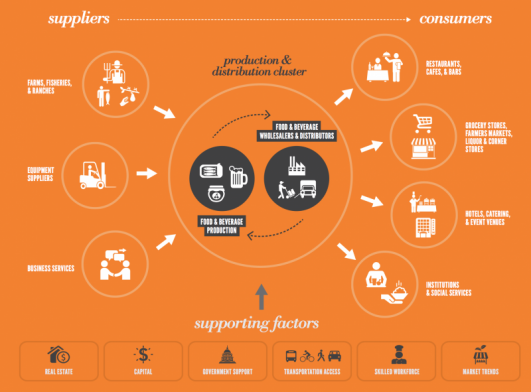Today, Mayor Ed Lee released San Francisco’s strategy to support the city’s food and beverage manufacturing and distribution industry. The report, the Makers & Movers Economic Cluster Strategy, is the result of a collaborative effort led by the San Francisco Planning Department, Office of Economic and Workforce Development (OEWD) and SPUR, and supported by a steering committee of food and beverage industry experts and city agency staff.

An "industry cluster," as illustrated in this diagram, refers to a network of industry sectors that create a supply chain based on a common set of economic activities. The strategy focuses on several core components of the Food and Beverage Industry Cluster, including food manufacturers, beverage manufacturers, and food and beverage wholesalers and distributors. Source: Makers & Movers Economic Cluster Strategy.
SPUR previewed some of the report’s major findings in the May issue of The Urbanist. Since that time the steering committee developed 13 recommendations grouped into four overarching strategies. Those strategies are:
1) Increase the supply of affordable, suitable production and distribution space for all business stages in San Francisco. Specific recommendations within this strategy include promoting development of new industrial space on private and public land as well as ensuring that existing space zoned for light industry is used for that purpose and not for alternate uses like office space.
2) Make it easier to do business in the city by providing technical support to existing and new businesses. A primary recommendation is to either create a new position or re-assign an existing staff member within OEWD to serve as a liaison with food and beverage production and distribution businesses. The liaison would help business owners connect with existing financial resources the city offers, navigate regulatory issues and facilitate real estate matchmaking. OEWD has already identified a staff person to start serving in this role, and the Planning Department has similarly identified staff who can provide information regarding the zoning code and building permitting issues.
3) Develop and retain a skilled local workforce for the food and beverage production and distribution industry. One of the biggest benefits the food and beverage cluster provides to San Francisco is job diversity. Many of the 5,000 jobs in distribution and manufacturing firms are open to workers who do not have advanced education. While starting level wages are usually low, the industry includes a career ladder that can lead to annual incomes averaging $56,000 in the distribution sector and $30,000 in the food manufacturing sector. Workforce training programs can help equip San Francisco residents with not only basic job readiness but could also provide training in specific skills such as truck driving, which would increase the pool of residents who are qualified to get their start in the industry.
4) Improve transportation access to production and distribution job sites for employees, and support efficient mobility for distributors. Recognizing that transit service is limited late at night and early in the morning — when many workers in the industry are commuting to their jobs — the city’s Late Night Transportation Working Group has already begun incorporating feedback from the food and beverage industry as it explores this issue. Moving products from the warehouse to retailers and restaurants can also be a challenge. The report calls on the Planning Department and the San Francisco Municipal Transportation Agency to pilot different models for commercial loading zones on city streets to help reduce the time it takes delivery vehicles to find parking as well as the hazards of double-parking.
OEWD and the Planning Department, along with other city agencies, have already begun implementing some of the recommendation in the report. Others recommendations, especially those related to the challenge of increasing the supply of affordable industrial space, will require concerted effort by the city and private developers in the months and years to come.
The publication of this report reflects the city’s commitment to helping food and beverage manufacturers and distributors start, stay and grow in the city. And, by providing city agencies with direction and a set of priorities, the report represents a significant step forward in translating that commitment into concrete action.
